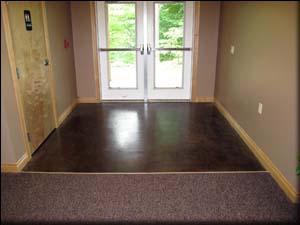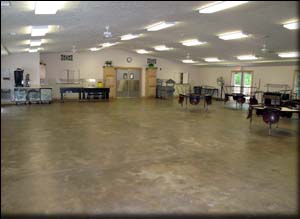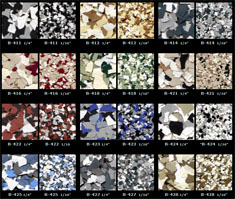Concrete Stains
What Are Concrete Stains?

There are two categories of concrete stains - reactive and nonreactive. Reactive stains are water-based acidic solutions containing metallic salts that react with the concrete's lime content. Once the chemical reaction takes place, the stain forms a permanent bond with the concrete and won't chip off or peel away.
Non-reactive stains are water-based acrylic stains that don't rely on a chemical reaction to impart color. Instead, they are formulated to penetrate the concrete surface and deposit their pigment particles in the open pores. Nonreactive stains have grown in popularity over the past few years because they come in a much broader palette of colors than acid stains and are easier to apply. The downside: They won't produce the same variegated, translucent color tones characteristic of acid stains. The color effects tend to be more opaque and more uniform.
Regardless of what stain colors you choose, be aware of the following caveats:
- With acid-based stains, wide color variations are normal. Surfaces will have a mottled, variegated appearance, and these variations will be emphasized when the final coat of sealer is applied.
- With some acid stain colors, what you see in liquid form may not be what you get once the stain has reacted with the concrete surface. The stain may not reveal its true color until it has been allowed to remain on the concrete for several hours or longer. Always apply the stain to a small test area before covering the entire surface.
- Color effects will generally be more intense on new concrete than on older or weathered concrete.
Why Use A Concrete Stain?

It boils down to one word: character. Concrete stain does more than simply add color. Rather than produce a solid, opaque effect like paint or colored coatings, stains permeate the concrete to infuse it with rich, deep, translucent tones. It is important to keep in mind even when treated with the same staining product in the same shade, no two concrete floors, walls, or countertops will look alike due to factors such as the composition and age of the concrete, surface porosity, texture, and environmental conditions. Some stain manufacturers use adjectives such as "antiqued," "variegated," or "mottled" to describe the distinctive look. It's this variability, rather than uniformity, that gives stained concrete its broad appeal and permits an infinite array of special effects.
Factors That Affect The Results Of Stains:
The acid in chemical stains opens the top surface of the concrete, allowing metallic salts to reach the free lime deposits. Water from the stain solution then fuels the reaction, usually for about a month after the stain has been applied. Other factors that affect the outcome include:
- Cement properties and amount
- Admixtures used
- Type of aggregate used
- Concrete finishing methods
- Concrete age and moisture content when stain is applied
- Weather conditions when stain is applied
- Efflorescence
In general, cements that produce larger amounts of calcium hydroxide during hydration will show more stain color, and higher cement contents pro-duce more intense colors. Air-entraining or water-reducing admixtures don’t pose a problem. However, calcium-chloride accelerators can cause very mottled, darkened areas, and for this reason aren’t recommended. Nonchloride accelerators don’t cause this mottling effect.
If they’re near the surface, calcium- based aggregates, such as lime-stone, take stain readily and deepen the color of the concrete above them. Siliceous aggregates, such as gravel, don’t react with the stain. Open finishes achieved by floating followed by minimal troweling take more stain and produce denser colors than do hard-troweled surfaces. However, open finishes lose color faster because the concrete wears away. Because of this, many contractors prefer staining hard-troweled surfaces because the stain color lasts longer. Colors on troweled surfaces also look richer than those on floated surfaces. But you have to grind the surface or use a higher acid concentration to ensure adequate stain penetration.
Slabs placed in wet weather result in a richer stain color if the concrete is stained soon after it’s placed. However, wet slabs are more likely to effloresce, lightening the color and causing a more mottled effect in areas where the stain doesn’t take because efflorescing salts hinder penetration. On sunny days, the concrete can become hot and dry, and the stains won’t penetrate as deeply into the concrete.
The continued presence of water will cause the reaction to continue for a long time, and concrete stained blue-green will gradually turn brown or even black. Initially, this provides nice variation to the appearance, but eventually, nearly all the blue-green color may change to brown and black. Because of the possible color shifts, some manufacturers advise against using these colors for exterior concrete. Interior slabs must be placed on a well-drained base or sub-grade and have a low moisture content before stain is applied. Jones believes the brown-colored "flowering" of blue-green stains is caused by oxidation of a copper component resulting from water vapor passing through the slab. Others believe the brown color is caused by a fungus, which can be eliminated by using sealers containing a fungicide
Service / Market Area:
For industrial and commercial flooring projects we work in Michigan cities such as Muskegon, Grand Haven, Norton Shores, Big Rapids, Cadillac, Reed City, Howell, Lansing, Jackson, Battle Creek, Kalamazoo, Hastings, Plainwell, Otsego, South Haven, Benton Harbor, St Joseph, Holland, Grand Haven, Grand Rapids, Wyoming, Kentwood, Grandville, Portage, Walker, Byron Center, Cascade Township, and Ada. For residential garage projects we generally only bid on work within 30 miles of Grand Rapids, MI.


